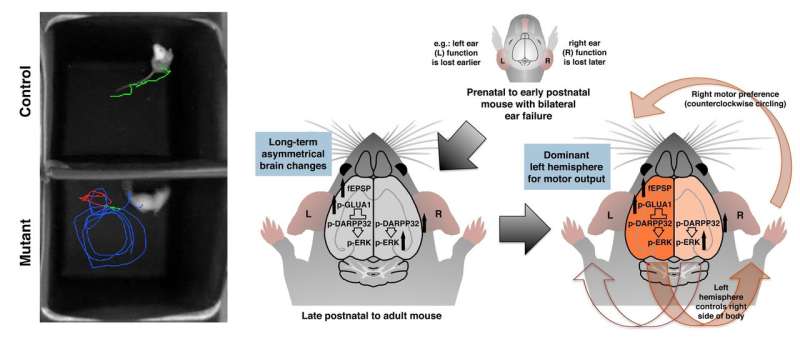Lopsided ear function can lead to lopsided brain development

Left-right differences in ear function have been found to lead to asymmetric brain development that affects the preferred direction of turning movement in mice. In a multi-national study publishing 13 March in the open access journal PLOS Biology, Michelle Antoine, Jean Hébert, and their colleagues at the Albert Einstein College of Medicine investigated the potential link between increased incidences of atypical asymmetries in motor behavior and defects in inner ear function.
Motor asymmetry is the preferential use of a limb or a body part on one side of the body, handedness or footedness being commonly known examples. Despite a long-standing fascination with asymmetries in left-right brain function by the public and scientific community alike, very little is known about the causes of functional brain asymmetry in mammals.
The authors used mice which have a genetic defect that affects the vestibular or balance-related function of their inner ear; these mice tend to "circle" repetitively, but their preferred direction of turning varies between individuals. Based on a series of genetic, surgical, and pharmacological experiments, researchers showed that even short-term imbalance of degenerating inner ear function in mice can lead to long-lasting asymmetries in the relative activity levels of two key neurotransmitters in the brain - glutamate and dopamine.
Asymmetry in these two neuronal signaling pathways correlated with the animal's preferred spontaneous turning direction, such that the motor-dominant hemisphere had higher levels of glutamate neurotransmission and lower levels of dopamine signaling.
Furthermore, the authors could lessen or reverse the preferred turning direction by experimentally manipulating the levels of a specific signaling pathway (involving a protein called ERK) that integrates both glutamate and dopamine neurotransmission.
The authors also showed that their findings in mice could extend to humans with normal ear function. In experiments in which human subjects underwent brain imaging during stimulation to each ear, the ear with the weakest vestibular brain response correlated with the motor-dominant hemisphere, as measured by the participant's handedness.
Functional brain asymmetry seems to arise independently of other anatomical asymmetries such as the positioning of the heart and liver, and no clear mechanism is known; by showing that early asymmetry in sensory input from the ear can permanently shape the asymmetric distribution of brain function, this study provides an important new insight.
More information: Antoine MW, Zhu X, Dieterich M, Brandt T, Vijayakumar S, McKeehan N, et al. (2018) Early uneven ear input induces long-lasting differences in left-right motor function. PLoS Biol 16(3): e2002988. doi.org/10.1371/journal.pbio.2002988


















